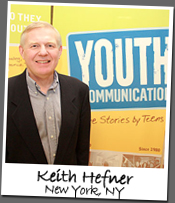Since 1980, I have been the executive director of Youth Communication, an afterschool writing and journalism program for teens. Youth Communication publishes magazines that are read by teens both in schools and afterschool programs. I decided to volunteer one day a week at the JHS 217 21st Century Community Learning Center to get a better sense of how middle school youth responded to our stories and lessons. Here are a few things I learned from my experience. When I first walked in - a 50 year old white guy - I knew I had no credibility with the kids. It was probably the opposite. My goal was to help the teens to improve their reading, writing, and thinking skills. But it was very tough to win their trust. If I passed out a worksheet, for example, they would act out and make it impossible to teach. I learned that the kids wanted to experience the emotions and the themes from the stories I brought with me - not just read about them in worksheet exercises. What they wanted to know is “are you going to see me for who I am?” Many of the kids I worked with are not doing well in school because they are dealing with a lot of emotional problems outside of the classroom. I had to develop reading and writing activities that tapped into these social and emotional issues in the teens’ lives, the topics they don’t get to explore in school. It took a lot of trial and error, but the lessons got better and better as I became more experienced. We published many of them in an afterschool anthology and leader’s guide called Real Stories, Real Teens. Once I got the kids interested in the stories - all of which are written by and about their peers - they forget that I am there. One story that I taught to an all-boys class is about a girl living with an alcoholic father. The story explains how the father’s job loss threatens the stability of his family and he must enter a residential rehabilitation program. As part of his rehab, the father and daughter participate in an exercise where they exchanged letters. After hearing the story, the boys started to share their own experiences dealing with an alcoholic father and the coping strategies they use to deal with their pain and anger. The openness and vulnerability they shared would not have happened in the classroom setting. We created a safe space for them via the storytelling. As the facilitator, I see how kids will take the discussion a little bit farther by sharing their own personal experiences. They can control how much they share by talking about the teen protagonist’s problems. At the same time, they the opportunity to explore the issues and theme through reading and role playing. In one session with a group of female students, we read a story about cutting. I structured the activity to focus the discussion around what the protagonist could do as an alternative coping strategy. We ended the exercise by asking the students who they could go to for help in a similar situation. One student opened up to the group to share her that she was cutting herself. As she spoke, her peers drew around her to show their support. It was clear that for many of them, this was the first time that they’d showed her any attention. But, I think that the story and discussion created a safe place for them to learn how to take action and help care for their friend. My experienced working with the teens has been invaluable to our work at Youth Communications. Afterschool programs help kids learn but they also teach them how to build strong relationships with peers and the adults in their lives. Now when I am working with a writer, I can see immediately which stories will resonate with the kids. Kids today have a lot say and a lot of emotions that they’re force to cap when they are around adults. We adults underestimate how much kids want to be heard and to be sounding boards. | 







